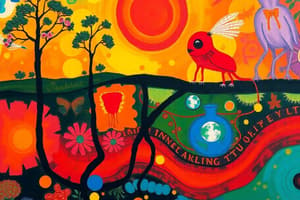Podcast
Questions and Answers
Why are there not more links in most food chains?
Why are there not more links in most food chains?
- Competition among species restricts the formation of longer chains.
- Limited resources prevent the addition of more links.
- Energy is lost at each trophic level, making longer chains inefficient. (correct)
- Predator-prey relationships become too complex with more links.
What is the ultimate source of energy in most ecosystems?
What is the ultimate source of energy in most ecosystems?
- Decomposers
- Consumers
- Producers
- Sunlight (correct)
Why is energy lost as it is transferred between trophic levels?
Why is energy lost as it is transferred between trophic levels?
- Organisms at higher trophic levels consume more energy.
- Heat is released during metabolic processes. (correct)
- Decomposition of dead organisms leads to energy loss.
- Not all consumed food is fully digested and absorbed.
What are biogeochemical cycles?
What are biogeochemical cycles?
How do humans impact ecosystems by altering biogeochemical cycles?
How do humans impact ecosystems by altering biogeochemical cycles?
What is Liebig’s Law of the Minimum?
What is Liebig’s Law of the Minimum?
Flashcards are hidden until you start studying
Study Notes
Ecosystems
- An ecosystem is a community of living and non-living components that interact with each other in a specific environment.
Trophic Structure
- The trophic structure of an ecosystem refers to the feeding relationships between organisms in an ecosystem.
- Organisms are divided into different trophic levels based on their position in the food chain.
- Producers (autotrophs) form the base of the trophic structure, followed by primary consumers (herbivores), secondary consumers (carnivores), and tertiary consumers (apex predators).
Trophic Levels
- Producers (autotrophs) convert sunlight into energy through photosynthesis.
- Primary consumers (herbivores) feed on producers.
- Secondary consumers (carnivores) feed on primary consumers.
- Tertiary consumers (apex predators) feed on secondary consumers.
Food Chains
- There are not more links in most food chains because energy is lost as it is transferred between trophic levels.
- This energy loss limits the number of trophic levels in an ecosystem.
Energy Source
- The ultimate source of energy in most ecosystems is sunlight.
Productivity
- Productivity refers to the rate of biomass production in an ecosystem.
- Limits to productivity include factors such as light, temperature, water, and nutrients.
- Terrestrial ecosystems with high productivity include tropical rainforests and coral reefs.
- Aquatic ecosystems with high productivity include phytoplankton and estuaries.
- Terrestrial ecosystems with low productivity include deserts and tundras.
- Aquatic ecosystems with low productivity include deep-sea vents and arctic lakes.
Energy Loss
- Energy is lost as it is transferred between trophic levels due to metabolic processes and heat loss.
Biogeochemical Cycles
- Biogeochemical cycles refer to the movement of nutrients and elements through ecosystems.
- The carbon cycle involves the exchange of carbon between the atmosphere, oceans, and land.
- The nitrogen cycle involves the conversion of nitrogen between its various forms, including nitrogen fixation, ammonification, and denitrification.
Human Impact
- Humans impact ecosystems by altering biogeochemical cycles through activities such as deforestation, fertilizer use, and burning fossil fuels.
Earth's Heating
- The earth is heated by the sun through radiation and conduction.
Air Circulation
- The basic patterns of air circulation include convection, wind patterns, and ocean currents.
- These patterns function due to differences in temperature and pressure between regions.
Local Climate Patterns
- Local effects on basic climate patterns include altitude, latitude, and proximity to large bodies of water.
- These factors influence the distribution of heat and precipitation around the globe.
Biomes
- Biomes can be identified based on their physical characteristics, including temperature, precipitation, and vegetation.
- Examples of biomes include deserts, grasslands, tropical rainforests, and tundras.
Liebig's Law
- Liebig's Law of the Minimum states that the growth of an organism is limited by the scarcest essential resource.
- This law applies to ecosystems, where the availability of certain resources can limit productivity and growth.
Studying That Suits You
Use AI to generate personalized quizzes and flashcards to suit your learning preferences.




